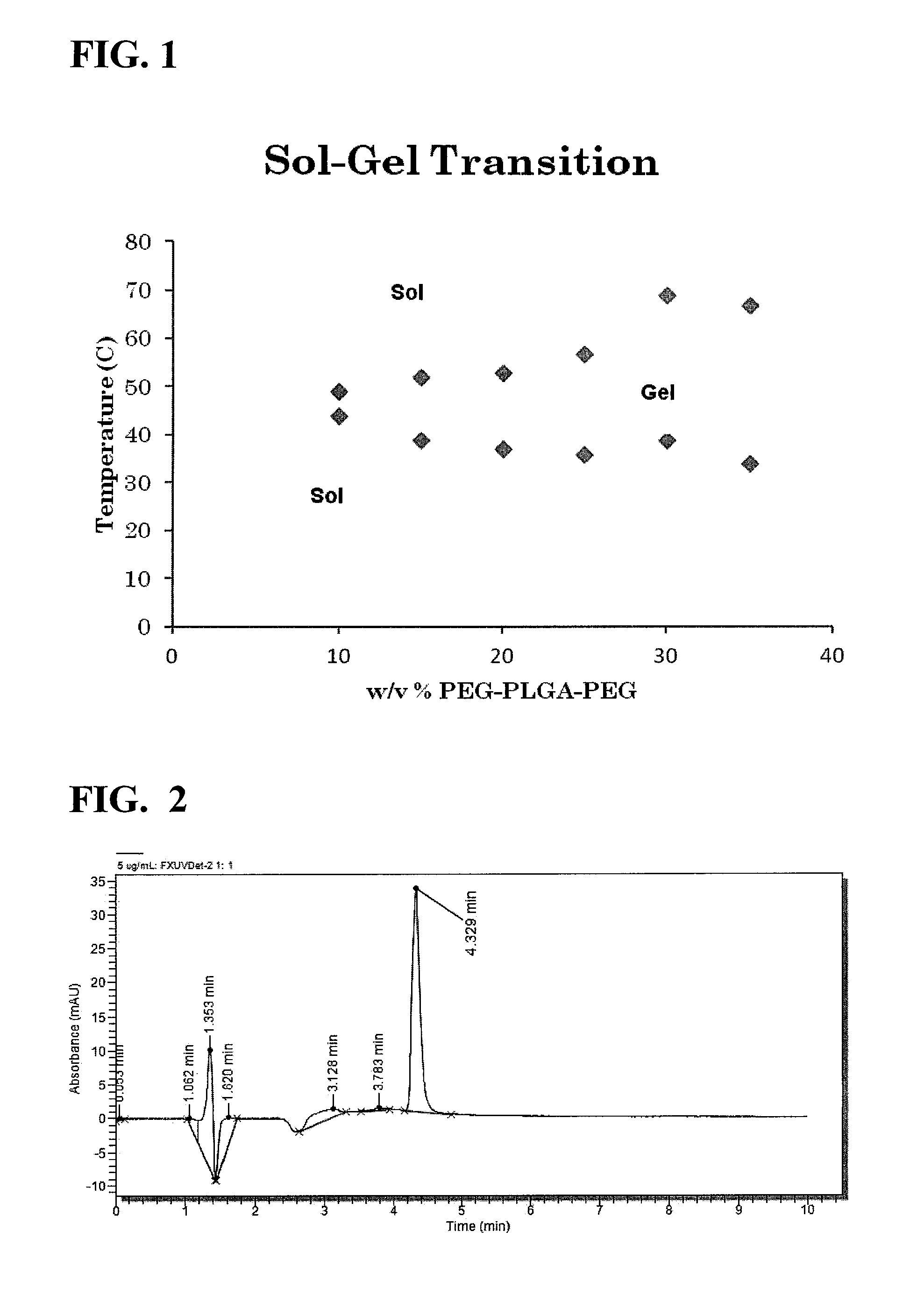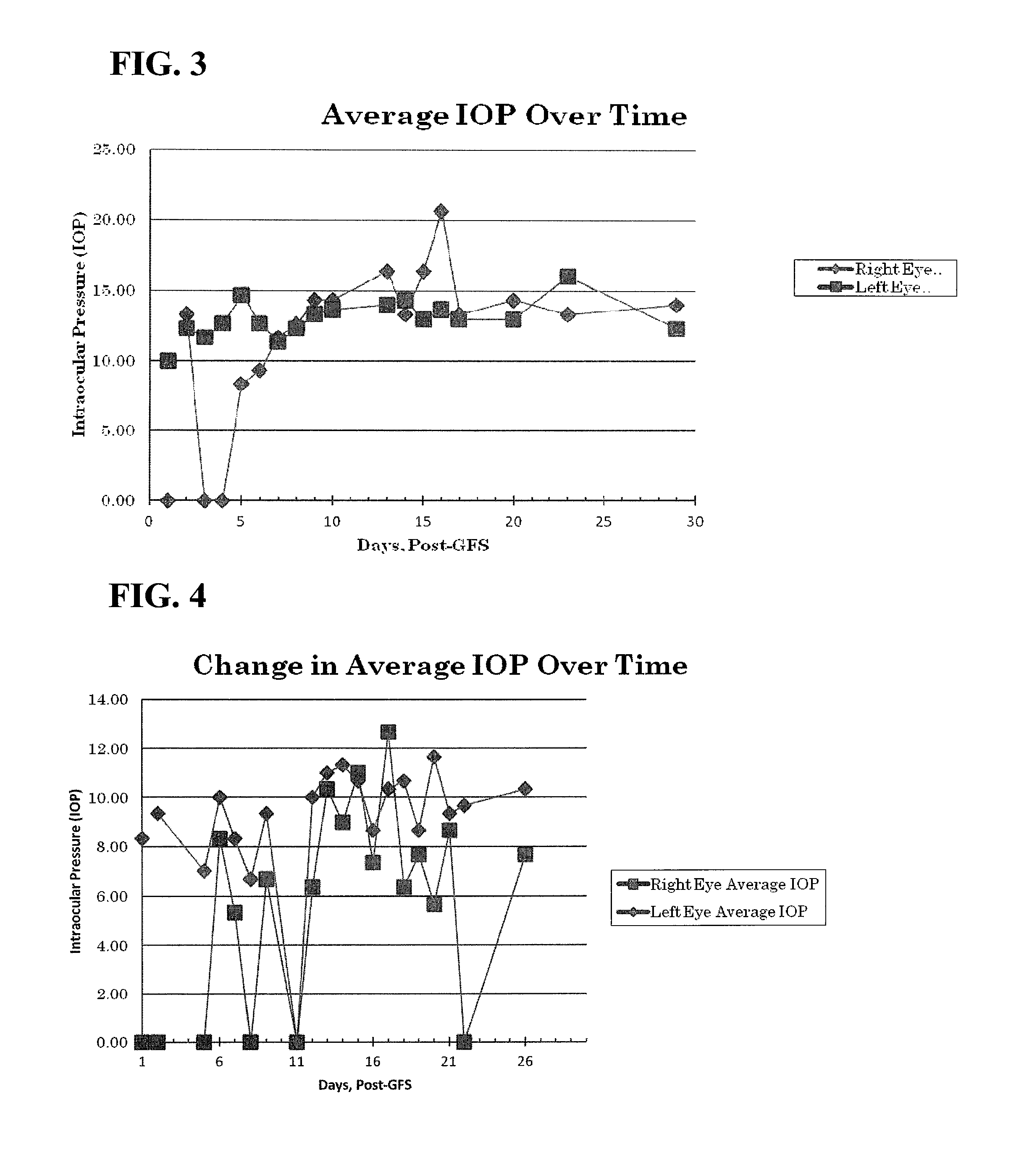Use of thermo-sensitive gel for controlled delivery of alk-5 inhibitors to the eye and related methods
a technology of controlled delivery and alk-5 inhibitors, which is applied in the direction of capsule delivery, microcapsules, nanocapsules, etc., can solve the problems of eye damage, impaired vision and blindness, and increased intraocular pressure, so as to prolong the period of filtering bleb survival
- Summary
- Abstract
- Description
- Claims
- Application Information
AI Technical Summary
Benefits of technology
Problems solved by technology
Method used
Image
Examples
example 1
Synthesis of the PLGA-PEG-PLGA Copolymer
[0054]PLGA-PEG-PLGA copolymer was synthesized through a ring opening copolymerization as described by Ghahremankhani et al., 2007 (Ghahremankhani AA, Dorkoosh F, Dinarvand R, Polymer Bulletin, 2007, 59, 637-646), the disclosure of which is hereby encorporated by reference in its entirety. PEG 1500 was loaded to a stainless steel reactor and heated for 2 hours at 150° C. at 5 mmHg vacuum. D,L-lactide (19.9 g) and glycolide (5.7 g) was melted at the same temperature for 30 min and stirred. Stannous 2-ethylhezanoate (0.04 g) was added as catalyst and heating was continued at 160° C. for 6 h under 5 mmHg vacuum. After the completion of reaction, the copolymer was dissolved in cold water (4° C.) and was heated to 80° C. to precipitate to remove impurities and unreacted material for purification. The resultant triblock polymer was of the polymer composition PLGA-PEG-PLGA. The approximate ratio of PLGA to PEG was 50:25 in the polymer.
example 2
Preparation of Formulation Containing PLGA-PEG-PLGA COPOLYMER 25% w / v And an ALK-5 Inhibitor
[0055]A formulation containing 25% w / v PLGA-PEG-PLGA co-polymer and 10 mg of the ALK-5 inhibitor SB-505124 was prepared by first dissolving 200 mg of the PLGA-PEG-PLGA copolymer of Example 1 in 1 ml of water at 4° C. and vortex mixing it for 10 minutes until the polymer is fully dissolved. Finally, 10 mg of SB-505124 powder was slowly added to the cold (4° C.) polymer solution and mixed. The dispersion was kept in the refrigerator (6-12 hours) until a suspension / solution was formed.
example 3
Preparation of Formulation Containing PLGA-PEG-PLGA Copolymer 25% w / v and Nanoparticles Containing an ALK-5 Inhibitor
[0056]A formulation containing 25% w / v PLGA-PEG-PLGA co-polymer and 10 mg of the ALK-5 inhibitor SB-505124 was prepared by first dissolving 200 mg of the PLGA-PEG-PLGA copolymer of Example 1 in 1 ml of water at 4° C. and stirring with magnetic stir bar. PLGA nanoparticles of an approximate MW of 8000 and containing the ALK-5 inhibitor SB-505124 were prepared from a 50:50 mixture of D,L-lactide and glycolide using the solvent evaporation method. The polymer and 10 mg of SB-505124 were dissolved in 3 ml acetone and the solution was added dropwise into a stirring solution of a phosphate buffer saline The solution was then stirred at 300 rpm for at least 2 hours. The nanoparticles were centrifuged for 30 minutes at 20,000×g, at 4° C. The liquid suspension containing the nanoparticles was added to a stirring 25% w / v polymer solution and suspended therein.
PUM
| Property | Measurement | Unit |
|---|---|---|
| weight | aaaaa | aaaaa |
| molecular weight | aaaaa | aaaaa |
| molecular weight | aaaaa | aaaaa |
Abstract
Description
Claims
Application Information
 Login to View More
Login to View More - R&D
- Intellectual Property
- Life Sciences
- Materials
- Tech Scout
- Unparalleled Data Quality
- Higher Quality Content
- 60% Fewer Hallucinations
Browse by: Latest US Patents, China's latest patents, Technical Efficacy Thesaurus, Application Domain, Technology Topic, Popular Technical Reports.
© 2025 PatSnap. All rights reserved.Legal|Privacy policy|Modern Slavery Act Transparency Statement|Sitemap|About US| Contact US: help@patsnap.com



